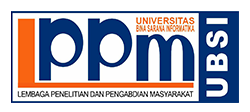Pengaruh Gaya Komunikasi,Motivasi Akademik, Kebiasaan Menonton Youtube terhadap Self Efficacy Akademik
Sari
Kata Kunci
Teks Lengkap:
PDFReferensi
Agezo, C. K. (2010). Why Teachers Leave Teaching : The Case of Pretertiary Institutions in Ghana. International Journal of Educational Reform, 19(1), 51–69.
Ahmad, N. K. (2019). Tantangan Aplikasi Sekolah Pintar di Kawasan Timur Indonesia. Inter Komunika: Jurnal Komunikasi, 4(1), 44–57.
Ameringen, M. Van, & Mancini, C. (2003). The impact of anxiety disorders on educational achievement. Journal of Anxiety Disorders, 17, 561–571.
Balakrishnan, V., Liew, T. K., & Pourgholaminejad, S. (2014). Fun learning with Edooware - A social media enabled tool. Computers & Education. https://doi.org/10.1016/j.compedu.2014.08.008
Blašková, M., Blaško, R., Jankalová, M., & Jankal, R. (2014). Key personality competences of university teacher : comparison of requirements defined by teachers and / versus defined by students. Social and Behavioral Sciences, 114, 466–475. https://doi.org/10.1016/j.sbspro.2013.12.731
Cassidy, S., & Eachus, P. (2000). Learning Style , Academic Belief Systems , Self-report Student Proficiency and An International Journal of Experimental. Educational Psychology, (September). https://doi.org/10.1080/713663740
Chawinga, W. D. (2017). Taking social media to a university classroom : teaching and learning using Twitter and blogs. International Journal of Educational Technology in Higher Education. https://doi.org/10.1186/s41239-017-0041-6
Cokley, K. O. (2000). Examining the Validity of the Academic Motivation Scale by Comparing Scale Construction to Self-Determination Theory. Psychological Reports, 86(2), 560–564.
Deci, E. L., & Ryan, R. M. (1990). A Motivational Approach to Self : Integration in Personality. Nebraska Symposium On Motivation, (May 2014).
Frith, C. (2009). Motivation to learn. Educational Communications and Technology, 1–14.
Frumkin, L. A., & Murphy, A. (2007). Student perceptions of lecturer classroom communication style. European Journal of Social Sciences, 5(3)(October), 45–60.
Greene, B. A., Miller, R. B., Crowson, H. M., Duke, B. L., & Akey, K. L. (2004). Predicting high school students Õ cognitive engagement and achievement : Contributions of classroom perceptions and motivation q. Contemporary Educational Psychology, 29, 462–482. https://doi.org/10.1016/j.cedpsych.2004.01.006
Guilford, J. . (1956). Fundamental Statistics in Psychology and Education (3rd Ed.). New York: McGraw‐Hill Book Company.
Hamdu, G., & Agustina, L. (2011). Pengaruh Motivasi Belajar Siswa Terhadap Pestasi Belajar Ipa Di Sekolah Dasar (Studi Kasus terhadap Siswa Kelas IV SDN Tarumanagara Kecamatan Tawang Kota Tasikmalaya). Jurnal Penelitian Pendidikan, 12(1), 139–147.
Hong, J., Hwang, M., Szeto, E., Tsai, C., & Kuo, Y. (2016). Internet cognitive failure relevant to self-ef fi cacy , learning interest , and satisfaction with social media learning. Computers in Human Behavior, 55, 214–222. https://doi.org/10.1016/j.chb.2015.09.010
Hua, K. (2015). Education as Entertainment: YouTube Sensations Teaching The Future. Retrieved from https://www.forbes.com/sites/karenhua/2015/06/23/education-as-entertainment-youtube-sensations-teaching-the-future/#5475edfb47c2
Khan, Khan, Zia-Ul-Islam, & Khan, 2017. (2017). Communication Skills of a Teacher and Its Role in the Development of the Students ’ Academic Success. Journal of Education and Practice, 8(1)(January), 18–21.
Lai, K. (2013). How are our undergraduates using YouTube? A survey on music students’ use of YouTube and the library’s multimedia collection. Library Journal Articles, 16, 199–217. https://doi.org/10.1080/10588167.2013.843361.
Lichter, J. (2012). Using YouTube as a Platform for Teaching and Learning Solubility Rules. Journal of Chemical Education, 89(9), 1133–1137.
Mutawakkil, & Nuraedah. (2019). Gaya Komunikasi Dosen dalam Pembelajaran Mahasiswa. Communicatus: Jurnal Ilmu Komunikasi, 3, 135–152. https://doi.org/10.15575/cjik.v3i2.5765
Ollerenshaw, jo A., & Creswell, J. W. (2002). Narrative research: A comparison of two restorying data analysis approaches. Qualitative Inquiry. https://doi.org/10.1177/10778004008003008
Pajares, F. (1996). Self-Efficacy Beliefs in Academic Settings. Review of Educational Research, 66(4), 543–578. https://doi.org/10.3102/00346543066004543
Pâni, G., Sandu, C., Pâni, I.-O., & Du, N. (2015). Comparative Study Regarding Communication Styles of The Students. Procedia - Social and Behavioral Sciences, 186, 202–208. https://doi.org/10.1016/j.sbspro.2015.04.066
Pratama, D. Y., Iqbal, I. M., & Tarigan, N. A. (2019). Makna Televisi Bagi Generasi Z. Inter Komunika: Jurnal Komunikasi, 4(1), 88–103.
Ryan, R. M., & Deci, E. L. (2000). Self-Determination Theory and the Facilitation of Intrinsic Motivation, Social Development, and Well-Being. American Psychologist, 55(1), 68–78.
She, H. C., & Fisher, D. (2002). Teacher communication behavior and its association with students’ cognitive and attitudinal outcomes in science in Taiwan. Journal of Research in Science Teaching, 39(1), 63–78. https://doi.org/10.1002/tea.10009
Silva, R., Rodrigues, R., & Leal, C. (2018). Academic Motivation Scale : Development , Application and Validation for Portuguese Accounting and Marketing Undergraduate Students. International Journal of Business and Management, 13(11), 1–16. https://doi.org/10.5539/ijbm.v13n11p1
Topham, P., & Russell, G. (2012). Social Anxiety in Higher Education. The Psychologist, 25(4), 280–282.
Tower, M., Latimer, S., & Hewitt, J. (2014). Social networking as a learning tool : Nursing students’ perception of efficacy. Nurse Education Today, 34(6), 1012–1017. https://doi.org/10.1016/j.nedt.2013.11.006
Triyanto. (2019). The Academic Motivation of Papuan Students in Sebelas Maret University , Indonesia. SAGE Open. https://doi.org/10.1177/2158244018823449
Vallerand, R. J., Pelletier, L. G., Blais, M. R., Briere, N. M., Senecal, C., & Vallieres, E. F. (1992). vallerand1992.pdf. Educational and Psychological Measurement, 52(4).
Verešová, M., Foglová, L., Vere, M., & Foglová, L. (2018). Academic Self-Efficacy , Approach to Learning and Academic Achievement Approach to Learning and Academic Achievement. https://doi.org/10.5772/intechopen.70948
Wilkesmann, U., Fischer, H., & Virgillito, A. (2015). Academic Motivation of Students - The German Case. Discussion Papers Des Zentrums Für HochschulBildung, (May).
Zeegers, P. (2007). Student learning in higher education : a path analysis of academic achievement in science. Higher Education Research and Development, 23(January 2015), 37–41. https://doi.org/10.1080/0729436032000168487
Zimmerman, B. J. (2000). Self-Efficacy : An Essential Motive to Learn. Contemporary Educational Psychology, 25, 82–91. https://doi.org/10.1006/ceps.1999.1016
DOI: https://doi.org/10.31294/kom.v8i1.9933
##submission.license.cc.by-nc-sa4.footer##
| Index by: | ||
       | ||
| E-ISSN: 2549-3299 | ||
  | ||
Dipublikasikan oleh LPPM Universitas Bina Sarana InformatikaJl. Kramat Raya No.98, Kwitang, Kec. Senen, Kota Jakarta Pusat, DKI Jakarta 10450 |






